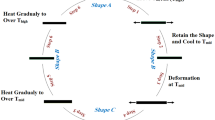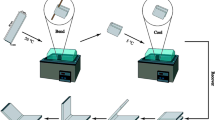Abstract
Fully biodegradable blends with low shape memory recovery temperature were obtained based on poly(lactic acid) (PLA) and poly(propylene carbonate) (PPC). By virtue of their similar chemical structures, in situ cross-linking reaction initiated by dicumyl peroxide (DCP) between PLA and PPC chains was realized in PLA/PPC blends. Therefore, the compatibility between PLA and PPC was increased, which obviously changed the phase structures and increased the elongation at break of the blends. The compatibilized blends had a recovery performance at 45 °C. Combining the changes of phase structures, the mechanism of the shape memory was discussed. It was demonstrated that in situ compatibilization by dicumyl peroxide was effective to obtain eco-friendly PLA/PPC blends with good mechanical and shape memory properties.
Similar content being viewed by others
References
Cha, K. J.; Lih, E.; Choi, J.; Joung, Y. K.; Ahn, D. J.; Han, D. K. Shape-memory effect by specific biodegradable polymer blending for biomedical applications. Macromol. Biosci. 2014, 14(5), 667–678.
Wong, Y. S.; Stachurski, Z. H.; Venkatraman, S. S. Modeling shape memory effect in uncrosslinked amorphous biodegradable polymer. Polymer 2011, 52(3), 874–880.
Kotharangannagari, V. K.; Krishnan, K. Biodegradable hybrid nanocomposites of starch/lysine and zno nanoparticles with shape memory properties. Mater. Design 2016, 109, 590–595.
Navarro-Baena, I.; Sessini, V.; Dominici, F.; Torre, L.; Kenny, J. M.; Peponi, L. Design of biodegradable blends based on PLA and PCL: from morphological, thermal and mechanical studies to shape memory behavior. Polym. Degrad. Stab. 2016, 132, 97–108.
Gu, S.; Gao, X.; Jin, S.; Liu, Y. Biodegradable shape memory polyurethanes with controllable trigger temperature. Chinese J. Polym. Sci. 2016, 34(6), 720–729.
Zini, E.; Scandola, M.; Dobrzynski, P.; Kasperczyk, J.; Bero, M. Shape memory behavior of novel (L-lactide-glycolidetrimethylene carbonate) terpolymers. Biomacromolecules 2009, 8(11), 3661–3667.
Xing, Q.; Li, R.; Dong, X.; Zhang, X.; Zhang, L.; Wang, D. Phase morphology, crystallization behavior and mechanical properties of poly(L-lactide) toughened with biodegradable polyurethane: effect of composition and hard segment ratio. Chinese J. Polym. Sci. 2015, 33(9), 1294–1304.
Talbamrung, T.; Kasemsook, C.; Sangtean, W.; Wachirahuttapong, S.; Thongpin, C. Effect of peroxide and organoclay on thermal and mechanical properties of PLA in PLA/NBR melted blend. Energy. Proced. 2016, 89, 274–281.
Jing, X.; Mi, H.; Peng, X.; Turng, L. The morphology, properties, and shape memory behavior of polylactic acid/thermoplastic polyurethane blends. Polym. Eng. Sci. 2015, 55(1), 70–80.
Wei, Z.; Long, C.; Yu, Z. Surprising shape-memory effect of polylactide resulted from toughening by polyamide elastomer. Polymer 2009, 50(5), 1311–1315.
Yuan, D.; Chen, Z.; Xu, C.; Chen, K.; Chen, Y. Fully biobased shape memory material based on novel cocontinuous structure in poly(lactic acid)/natural rubber TVPs fabricated via peroxide-induced dynamic vulcanization and in situ interfacial compatibilization. ACS Sustain. Chem. Eng. 2015, 3(11), 2856–2865.
Barreto, C.; Altskär, A.; Fredriksen, S.; Hansen, E.; Rychwalski, R. W. Multiwall carbon nanotube/ppc composites: preparation, structural analysis and thermal stability. Eur. Polym. J. 2013, 49(8), 2149–2161.
Wang, X. Y.; Weng, Y. X.; Wang, W.; Huang, Z. G.; Wang, Y. Z. Modification of poly(propylene carbonate) with chain extender ADR-4368 to improve its thermal, barrier, and mechanical properties. Polym. Test 2016, 54, 301–307.
Xing, C.; Wang, H.; Hu, Q.; Xu, F.; Cao, X.; You, J. Mechanical and thermal properties of eco-friendly poly(propylene carbonate)/cellulose acetate butyrate blends. Carbohyd. Polym. 2013, 92(2), 1921–1927.
Hu, X.; Xu, C.; Gao, J.; Yang, G.; Geng, C.; Chen, F. Toward environment-friendly composites of poly(propylene carbonate) reinforced with cellulose nanocrystals. Compos. Sci. Technol. 2013, 78(2), 63–68.
Cui, S.; Li, L.; Wang, Q. Enhancing glass transition temperature and mechanical properties of poly(propylene carbonate) by intermacromolecular complexation with poly(vinyl alcohol). Compos. Sci. Technol. 2016, 127, 177–184.
Seo, J.; Jeon, G.; Jang, E. S.; Khan, S. B.; Han, H. Preparation and properties of poly(propylene carbonate) and nanosized zno composite films for packaging applications. J. Appl. Polym. Sci. 2011, 122(2), 1101–1108.
Song, P.; Xiao M.; Du, F.; Wang, S.; Gan, L.; Liu, G. Synthesis and properties of aliphatic polycarbonates derived from carbon dioxide, propylene oxide and maleic anhydride. J. Appl. Polym. Sci. 2008, 109(6), 4121–4129.
Wang, S., Du, L., Zhao, X., Meng, Y., Tjong, S. Synthesis and characterization of alternating copolymer from carbon dioxide and propylene oxide. J. Appl. Polym. Sci. 2010, 85(11), 2327–2334.
Li, Z.; Li, W.; Zhang, H.; Dong, L. Thermal, rheological and mechanical properties of poly(propylene carbonate)/methyl methacrylate-butadiene-styrene blends. Iran. Polym. J. 2015, 24(10), 861–870.
Zhou, L.; Zhao, G.; Jiang, W. Effects of catalytic transesterification and composition on the toughness of poly(lactic acid)/poly(propylene carbonate) blends. Ind. Eng. Chem. Res. 2016, 55(19), 5565–5573.
Chen, Y.; Peng, Y.; Liu, W.; Zeng, G.; Li, X.; Yan, X. Study on the mechenical properties of PPC/PLA blends modified by poss. Adv. Mater. Res. 2013, 741, 28–32.
Gao, J.; Fu, Q.; Bai, H.; Zhang, Q. Effect of homopolymer poly(vinyl acetate) on compatibility and mechanical properties of poly(propylene carbonate)/poly(lactic acid) blends. Express Polym. Lett. 2012, 6(11), 860–870.
Yao, M.; Deng, H.; Mai, F.; Wang, K. Modification of poly(lactic acid)/poly(propylene carbonate) blends through melt compounding with maleic anhydride. Express Polym. Lett. 2011, 5(11), 937–949.
Hwang, S. W.; Park, D. H.; Kang, D. H.; Lee, S. B.; Shim, J. K. Reactive compatibilization of poly(L-lactic acid)/poly(propylene carbonate) blends: thermal, thermomechanical, and morphological properties. J. Appl. Polym. Sci. 2016, 133(18), DOI: 10.1002/APP.43388
Yuan, D.; Xu, C.; Chen, Z.; Chen, Y. Crosslinked bicontinuous biobased polylactide/natural rubber materials: super toughness, “net-like”-structure of NR phase and excellent interfacial adhesion. Polym. Test 2014, 38, 73–80.
Xu, P.; Ma, P.; Cai, X.; Song, S.; Zhang, Y.; Dong, W. Selectively cross-linked poly (lactide)/ethylene-glycidyl methacrylate-vinyl acetate thermoplastic elastomers with partial dual-continuous network-like structures and shape memory performances. Eur. Polym. J. 2016, 84, 1–12.
Raidt, T.; Hoeher, R.; Katzenberg, F.; Tiller, J. C. Chemical cross-linking of polypropylenes towards new shape memory polymers. Macromol. Rapid Commun. 2015, 36(8), 744–749.
Wang, Y.; Zhu, G.; Tang, Y.; Xie, J.; Liu, T.; Liu, Z. Mechanical and shape memory behavior of chemically cross-linked SBS/LDPE blends. J. Polym. Res. 2014, 21(4), 1–10.
Ma, P.; Cai, X.; Zhang, Y.; Wang, S.; Dong, W.; Chen, M.; Lemstra, P. J. In situ compatibilization of poly(lactic acid) and poly(butylene adipate-co-terephthalate) blends by using dicumyl peroxide as a free-radical initiator. Polym. Degrad. Stab. 2014, 102(2), 145–151.
Akos, N. I.; Wahit, M. U.; Mohamed, R.; Yussuf, A. A. Preparation, characterization, and mechanical properties of poly(ε-caprolactone)/polylactic acid blend composites. Polym. Compos. 2013, 34(5), 763–768.
Rytlewski, P.; Żenkiewicz, M.; Malinowski, R. Influence of dicumyl peroxide content on thermal and mechanical properties of polylactide. Int. Polym. Proc. 2013, 26(5), 580–586.
Lim, S. W.; Choi, M. C.; Jeong, J. H.; Park, E. Y.; Ha, C. S. Toughening poly(lactic acid) (PLA) through reactive blending with liquid polybutadiene rubber (LPB). Compos. Interface. 2016, 23(8), 807–818.
Agarwal, M.; Koelling, K. W.; Chalmers, J. J. Characterization of the degradation of polylactic acid polymer in a solid substrate environment. Biotechnol. Prog. 1998, 14(3), 517–526.
Fei, B.; Chen, C.; Peng, S.; Zhao, X.; Wang, X.; Dong, L. FTIR study of poly(propylene carbonate)/bisphenol A blends. Polym. Int. 2010, 53(12), 2092–2098.
Acknowledgments
This work was financially supported by the National Natural Science Foundation of China (No. 51503117) and the Innovation Foundation for Graduate Students of Shandong University of Science and Technology, China (No. SDKDYC170334).
Author information
Authors and Affiliations
Corresponding authors
Rights and permissions
About this article
Cite this article
Qin, SX., Yu, CX., Chen, XY. et al. Fully Biodegradable Poly(lactic acid)/Poly(propylene carbonate) Shape Memory Materials with Low Recovery Temperature Based on in situ Compatibilization by Dicumyl Peroxide. Chin J Polym Sci 36, 783–790 (2018). https://doi.org/10.1007/s10118-018-2065-3
Received:
Accepted:
Published:
Issue Date:
DOI: https://doi.org/10.1007/s10118-018-2065-3




